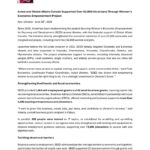In what analysts are calling a decisive pivot in Canada’s international trade strategy, Finance Minister Mark Carney unveiled an ambitious plan yesterday to diversify the nation’s economic partnerships beyond its traditional reliance on the United States. Speaking from Ottawa’s National Press Theatre, Carney’s announcement comes amid escalating trade tensions with Canada’s southern neighbor and signals a potential reorientation of the country’s economic future.
“While the United States remains our most significant trading partner, recent developments have made it clear that Canada must establish stronger commercial relationships across the globe,” Carney stated, referencing the series of punitive tariffs imposed by Washington over the past eighteen months. “Economic resilience requires multiple pathways to prosperity.”
The comprehensive strategy targets accelerated trade growth with the European Union, expanding the effectiveness of the Comprehensive Economic and Trade Agreement (CETA) that has underperformed initial projections since its implementation. Data from Statistics Canada shows that despite CETA’s promise, EU-Canada trade has increased by only 8.3% since the agreement took effect—significantly below the 20% growth that economists had forecast.
Even more notable is the plan’s emphasis on deepening economic integration with fast-developing Indo-Pacific economies. The finance ministry projects that trade with this region could double within five years under the new framework, potentially creating over 125,000 jobs across Canada’s manufacturing and service sectors.
“This isn’t abandoning our American partnership but rather building additional foundations for Canadian prosperity,” explained Dr. Elise Chen, Director of International Trade Studies at the University of Toronto. “The data clearly shows that nations with diversified trade portfolios weathered the pandemic-era economic disruptions more effectively.”
The policy shift arrives at a particularly fraught moment in Canada-U.S. relations. Last month, Washington expanded aluminum tariffs that now cover nearly 70% of Canadian exports in the sector, dealing a $3.8 billion annual blow to Canadian producers. The Biden administration has defended these measures as necessary protections for American workers, while Ottawa has consistently characterized them as violations of USMCA provisions.
Perhaps most surprising was Carney’s announcement of a dedicated $2.7 billion transition fund to help Canadian businesses previously dependent on American markets to retool for new international opportunities. The program includes specialized export development grants, logistics subsidies, and regulatory navigation assistance.
Business leaders across Canada have responded with cautious optimism. “We’ve been advocating for this type of strategic pivot for years,” remarked Jasmine Wong, President of the Canadian Manufacturers and Exporters association. “The implementation timeline is aggressive, but if executed properly, this could represent the most significant reorientation of our trade policy since NAFTA.”
Not all reactions have been positive, however. Opposition critics have questioned whether sufficient consultation occurred with industries that might face disruption. Conservative finance critic Pierre Poilievre characterized the plan as “recklessly antagonizing our largest trading partner while chasing uncertain opportunities elsewhere.”
Trade policy experts note that the success of Carney’s strategy depends heavily on how the United States responds. “The American market represents 76% of Canadian exports,” notes international economics professor Martin Dubois of McGill University. “Even the most ambitious diversification cannot quickly replace that relationship if it deteriorates further.”
The announcement coincides with emerging data showing Canadian businesses already beginning to shift supply chains away from the United States. A recent survey by the Canadian Chamber of Commerce found that 47% of export-oriented companies have reduced their reliance on American markets over the past two years—a striking change from historical patterns.
As global trade patterns continue evolving, the question remains whether Canada’s bold policy shift represents prudent economic insurance or a potentially costly gamble. Will Canadian businesses successfully navigate this transition, or might the pursuit of new partners risk damaging a relationship that has defined North American commerce for generations?










